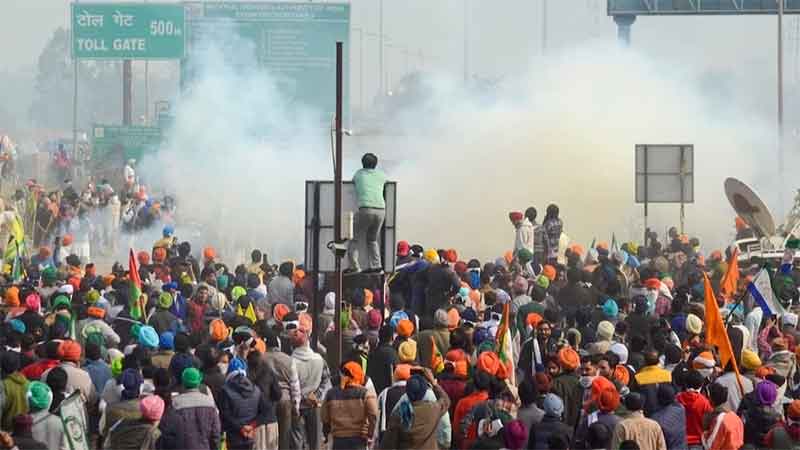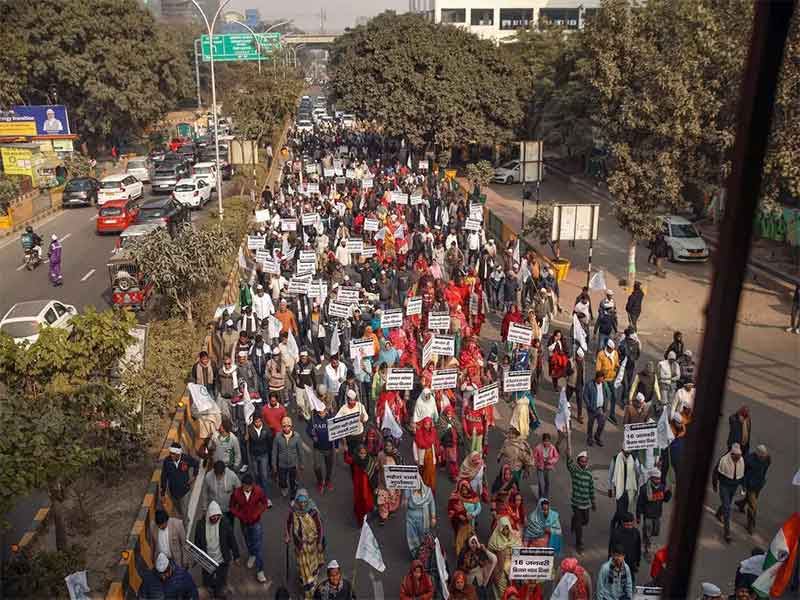
After several rounds of talks between the representatives of Kisan organisations and a group of ministers the deadlock continues. There is no further progress towards settling the issues/demands raised by the Kisan movement. This Impasse is causing a lot of hardship for the participants in the cold and harsh winter weather. It has already taken life of several farmers, more than hundred till this time. It is also affecting adversely economic and social life in the north-west India. In the Covid pandemic the country is already suffering with negative economic growth along with many deaths due to health related issues. In such a situation country can not afford a long period of conflict in the country. There is immediate need to host meaningful dialogue between the government and the leaders of Kisan movement to solve the problems of agriculture in the country.
The demonstrators are consisting of old and young both male and female farmers from different parts of the country. The participants are sitting on the outskirt of Delhi on all the highways from the surrounding states such as Haryana, UP, and Rajasthan. A large number of farmers and their supporters from Punjab, Haryana, UP, Rajasthan and other states have come with their tractors and trolleys which are providing them temporary shelters. Along with the ration which these protestors have brought, they are getting a lot of support from the towns and villages near the dharna sites. The present struggle of the farmers started as an agitation in the month of June in Punjab. It was transformed into a movement/ Jan Adolan when the Punjab Assembly passed a resolution on 22nd October 2020 supported by all political parties in the state except the BJP.
Then the focus of this movement shifted from Chandigarh to Delhi from 26th of November. The leaders of this movement had decided to keep this movement peaceful and disciplined whatever the provocation may be. The Haryana farmers have joined them in a large number and ignoring all attempts to separate them from Punjab farmers. As the the farmers were not allowed to enter Delhi they started their sit in dharna at Singhu border followed by dharna on national highways coming from all sides to Delhi. They are sitting peacefully and sharing their meals with everyone including the local poor. This movement which began from Punjab had been joined by farmers from states such as Haryana, UP, MP, Rajasthan, Maharashtra, Gujarat, Bihar, Odisha, Tamil Naidu, Kerala, Karnataka, etc. With joining of farmers from other states and all India organizations of the farmers, this has become an all India movement.
The character of this movement got further transferred with the support coming from small traders, employees unions/associations, workers unions, writers, artists, teachers, lawyers, doctors. This is the first movement in the country joined by a large number of ladies of all ages and youth in a large number.It is also supported by a large number of self help social and philanthropic volunteer organizations to help the farmers. This is a movement which is purely people’s Movement and not led by any political party. This movement has built a new social discourse. This is against the Corporatisation of the economy especially that of agriculture. It is also against the Corporatisaton of the State/ governance in the country. It is also a movement against the centralisation of governance. It for strengthening of federalism and decentralised governance. It for strengthening of democracy with participation of common men and women in decision making. It for strengthening of Institutions like judiciary, Parliamentary system autonomy of the investigation agencies. The Movement has Produced its own intellectuals in the form a large number of farmers’ leaders who are well read and understand the farm Acts, economics of corporate trading and above all high-handedness of established political leaders.
They neither trust the political leaders nor the Crony corporates. They are able to conduct negotiations with the team Central Ministers confidently and in a transparent manners. They can handle media and understand the game of corporate media and have started their own paper, Trolley Times. They handled wisely the attempt by the power that may be to malign them as anti national, parochial, communal or misguided by opposition parties. At the top of it they have been successful in pointing out serious flaws in the Three Agrarian Acts. This has been accepted by the the Union Government. They understand the deep structure of these laws , Electricity Bill and Parali Ordinance. This is a movement for justice to the farmers and rural areas which has suffered during the reform period since 1991 leading to marginalisation of farming, farmers and rural areas. This is for justice to a large number of farmers and agricultural labourers who have committed suicides. Officially this number is more than 3.5 lakh between 1997 to 2017. The Parliament and political class never found time to discuss the woes of such a large population which is more 2/3rd of the total in the country.
The Impasse between the government and the Kisan leadership has emerged on several counts. There is an ego factor in the government circles that it enjoys thumping majority in the Parliament and has a vast party network matched by none other party or formation in the country. It has a formidable leader in Shree Narinder Modi who is communicator par excellence. It has with it very learned group of advisors and seasoned civil servants. Its authority is being questioned by a newly organised movement of the farmers with simple rural leadership. The government circles consider the present movement as an agitation of a segment of farmers from a small region primarily from Punjab and Haryana. They are not looking at all India and global support to this movement. This is understandable but the farmers have shown their maturity of leadership. There is a wide difference of perspectives between the government and the farmers. The government stands for centralisation of rule and governance while the farmers want decentralised rule and governance. The government is committed to involvement of corporate companies in Agricultural trade, storage and processing while the farmers do not trust the corporate companies who look at them as potential threat to the very existence the farming community.
This is the reason that the government is not willing to withdraw these Act though is willing to amend them. This is not acceptable to the farmers. Thirdly there are a large number of experts within the government and a large number of them outside the government but closer to corporate funded Institutions, think tanks and lobbyists. These experts are market fundamentalists and are continuously creating pressure on the government against a compromise on terms acceptable to the farmers. These market fundamentalists consider that yielding to farmers farmers pressure means stoppage of neo liberal reforms. They consider that excessive democracy is not in the interest of fast growing economy. These experts have a large support from mainstream economists from major universities in the advanced countries. But such economists lack comprehensive understanding of ground reality in the rural India. Lastly the the pressure of global agencies like the World Bank, WTO , and think thanks , lobbyist sponsored by corporate groups and others is also there to liberalise agriculture trade in favour of domestic and foreign corporate companies. Former President Barack Obama has mentioned in detail about working of such think tanks and lobbyists in in the US in his recently (2020) published book titled as “A Promised Land”. Such think tanks and lobbyists of corporates have also springed up in India after 1991. Many experts from such groups are continuously arguing against farmers and their demands in their articles in the print media and prime time debates on the TV channels. Sometimes these experts cook up data and quote as authentic research studies to prove their point.The names of such lobbyists can be easily identified but need not be mentioned. These road blocks will have to be cleared to reach acceptable solution to the farmers’ Movement.
The continuing conflict between the government and the farmers is neither in the interest of the farmers nor the government. The sufferings of the farmers can not be discounted. They have lost many participants due to cold, tension and road accidents. Their work home requires their continuous presence to tend to milch animals daily and also look after their crops. Many farmers are falling sick and are injured during the on going process. The Impasse can be overcome if the government takes a larger interest of the country in view and accept farmers’ demand and engage the States to enact legislation which suites the agrarian situation in each region. This will also restore diminished federalism in the country.
Sucha Singh Gill, Professor, CRRID, Chandigarh
IF YOU LIKED THE ARTICLE SUPPORT PEOPLE’S JOURNALISM













































